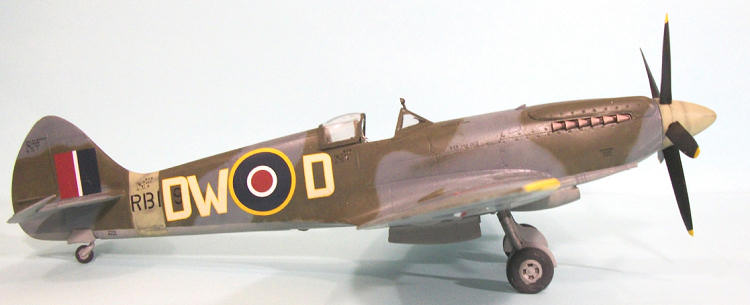
Pacific Coast 1/32 Spitfire XIVc/e
| KIT #: | 32015 |
| PRICE: | $69.95 SRP |
| DECALS: | Seven options |
| REVIEWER: | Tom Cleaver |
| NOTES: |

| HISTORY |
Development of the Spitfire to use the more powerful Rolls‑Royce
Griffon engine began in late 1940 with the Type 337. The airframe
involved extensive modification to absorb the additional power; at one
time it flew with a mockup of no less than three 20mm cannon in each
wing. Before the prototype,
DP845, flew, it was designated the Spitfire XX to distinguish it from
the P.R. Mk. IV. Plans that
only XX‑series Spitfires would be Griffon‑powered were changed when the
interim Mk. XII and Mk. XIV types were introduced.
In order
to gain further experience with the Griffon‑61, six Mk. VIII airframes
were modified. Experience
with these showed it would be possible to create a Griffon-powered
high‑altitude air superiority fighter in a faster time frame than
envisioned with the Spitfire XXI; this was designated the Spitfire
XVIII. However, by mating
the Griffon-65 with 2.050 h.p. to a beefed-up Mk. VIII airframe the way
the Merlin‑61 had been mated to the Spitfire V, a Griffon-powered air
superiority fighter could be created even more quickly (as happened with
the Spitfire VIII and IX).
Thus, the third major development of the Spitfire again saw the
“interim” type produced in larger numbers and used more widely than the
versions developed specifically to use the more powerful engine.
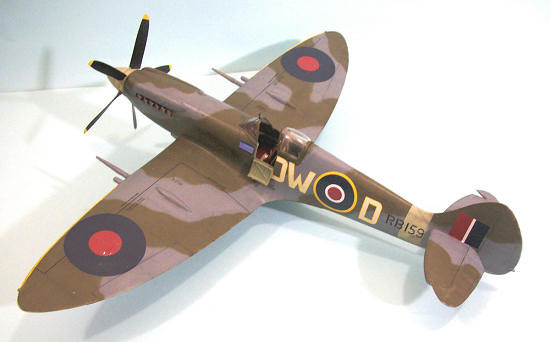 The first squadron to re-equip with the new type was 610, a
former RAuxAF squadron commanded by Squadron Leader Dickie Newbery,
which had been among the first squadrons equipped with the original
Spitfire. 610 moved to
The first squadron to re-equip with the new type was 610, a
former RAuxAF squadron commanded by Squadron Leader Dickie Newbery,
which had been among the first squadrons equipped with the original
Spitfire. 610 moved to
While 610 was working up, 91 Squadron exchanged their Spitfire
XIIs for Spitfire XIVs in February, while the Dutch 322 Squadron
re-equipped in early March.
On March 7, 1944, 610 gave the Spitfire XIV its blooding when P/O Hussey
and F/Sgt Harding were vectored on to three Fw-190 Jabos off the Devon
coast and gave chase; the combat resulted only in a claim for one
“damaged,” but the pilots had found that the Spitfire XIV would
outperform and out-maneuver the radial-engined Fw-190 at low level.
With slow deliveries, 610 was only fully equipped with the new
type by mid-April, and gave a public display of their new mounts in
mid‑May 1944. With 91 and
322 quickly becoming fully-equipped, the
The Spitfire
XIV was intended to provide high altitude air superiority, to complement
the medium‑altitude Tempest V.
Both types saw their entry into air combat over the Continent
following D‑Day delayed by the deployment of the Fi‑103 “buzz bomb,” the
first of which exploded in 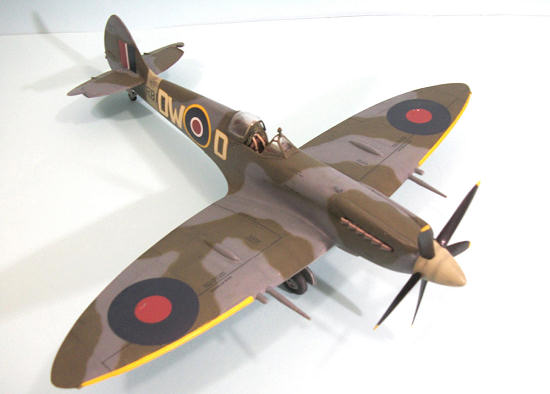 against
these robots were standing patrols by the fastest Allied fighters.
Over the course of the anti‑diver campaign, which only ended when
the launch sites in Belgium were overrun by the Allied armies in
September 1944, the Spitfire XIV emerged as the most successful of all
Spitfire types in destroying the “buzz bombs,” being flown by two wings
at the time, with a third re‑equipping just at the end of the campaign.
Among the “Diver aces” was 610's leader, Dickie Newbery, who
scored seven V-1s.
against
these robots were standing patrols by the fastest Allied fighters.
Over the course of the anti‑diver campaign, which only ended when
the launch sites in Belgium were overrun by the Allied armies in
September 1944, the Spitfire XIV emerged as the most successful of all
Spitfire types in destroying the “buzz bombs,” being flown by two wings
at the time, with a third re‑equipping just at the end of the campaign.
Among the “Diver aces” was 610's leader, Dickie Newbery, who
scored seven V-1s.
The Mk.
XIV arrived on the Continent at about the same time the Luftwaffe
re‑equipped with the Fw‑190D‑9.
The Spitfire XIV had superior performance above 25,000 feet, but
most fights over the Western Front were occurring at lower altitudes,
though the Spitfire XIV retained tha ability to turn inside both the
Fw-190d-9 and the Bf-109G-10 and K-4.
Thus, as had been the case with the Spitfire since the first
introduction of the Fw‑190, the new version just maintained superiority
over the latest 190, with pilot quality (declining for the Germans)
being the deciding element.
The Spitfire XIVs were based at Volkel,
By V‑E
Day, 20 RAF squadrons were equipped with the Spitfire XIV in
| THE KIT |
There have been three Spitfire XIV kits released in 1/72 scale and
two, by Academy and Hobbycraft, in 1/48.
None have been entirely “right.”
This kit by
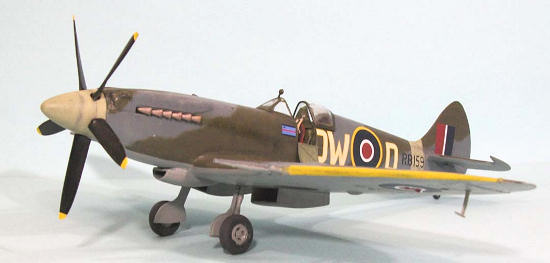 foot
there are no obvious external differences.
Yes, the Tamiya kit has greater detail, but the PCM kit is entirely
acceptable, and this one is too.
Given that Tamiya is going to be involved over the next few years
with the release of a later-version P-51D, the P-51B/C and the “next big
thing” (smart money is betting on an F4U-1 Corsair series), this Griffon
Spitfire from PCM is going to be what’s there for Spitfire modelers who tire
of doing the hyper-expensive Tamiya Merlin-60 series fighters.
foot
there are no obvious external differences.
Yes, the Tamiya kit has greater detail, but the PCM kit is entirely
acceptable, and this one is too.
Given that Tamiya is going to be involved over the next few years
with the release of a later-version P-51D, the P-51B/C and the “next big
thing” (smart money is betting on an F4U-1 Corsair series), this Griffon
Spitfire from PCM is going to be what’s there for Spitfire modelers who tire
of doing the hyper-expensive Tamiya Merlin-60 series fighters.
The one complaint I have is that the profiles were created by the
well-known Richard Caruana, who makes his usual lazy mistakes.
Most prominently, he completely botches the Spitfire XIVe flown by
Ginger Lacey, opting to create the restored 1980s warbird originally flown
by The Fighter Collection at Duxford and today owned by Cinema Air in
| CONSTRUCTION |
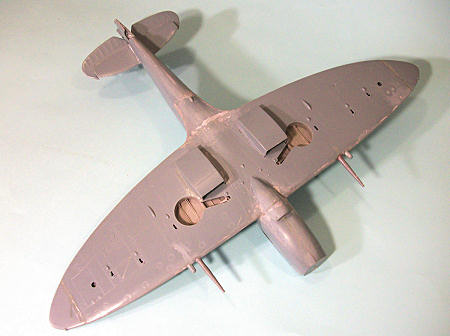 While this kit is limited-run, it fits together very well.
After cleaning up all the joints and with careful assembly, I only
needed a very thin coat of Tamiya Surfacer on the centerline seam and
wing-fuselage joints to get everything nice and smooth.
While this kit is limited-run, it fits together very well.
After cleaning up all the joints and with careful assembly, I only
needed a very thin coat of Tamiya Surfacer on the centerline seam and
wing-fuselage joints to get everything nice and smooth.
After attaching the wing and fuselage sub-assemblies, I attached the horizontal stabilizers. I cut off the elevators so they could be posed drooped.
| COLORS & MARKINGS |
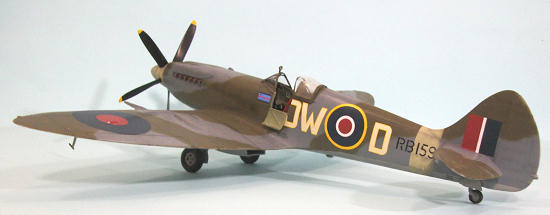 I first pre-shaded the model with airbrushed flat black.
The spinner and the fuselage band were painted with Tamiya “J.A.
Grey” a greenish-grey close to Sky that was very close to the color of the
ID letters, and painted the leading edges of the wings with Tamiya Flat
Yellow. These areas were masked
off and the lower surface was painted with Tamiya “RAF Sea Grey Medium,”
while the upper surfaces were painted with Tamiya “RAF Ocean Grey” and “RAF
Dark Green,” new colors that came out with the release of the Spitfire
uberkits. I finished off with a
coat of Xtracrylix Gloss.
I first pre-shaded the model with airbrushed flat black.
The spinner and the fuselage band were painted with Tamiya “J.A.
Grey” a greenish-grey close to Sky that was very close to the color of the
ID letters, and painted the leading edges of the wings with Tamiya Flat
Yellow. These areas were masked
off and the lower surface was painted with Tamiya “RAF Sea Grey Medium,”
while the upper surfaces were painted with Tamiya “RAF Ocean Grey” and “RAF
Dark Green,” new colors that came out with the release of the Spitfire
uberkits. I finished off with a
coat of Xtracrylix Gloss.
The kit decals were used and presented no problems, other than they
are thin and must be initially applied with a lot of water on the model
surface until you get the decal in position, though you do not want to use
much water at all when applying the wingwalk markings.
I then blotted the water with tissue paper and applied a light coat
of Micro-Sol, which put everything down very nicely.
| FINAL CONSTRUCTION |
 Photos of this airplane show it very clean and polished.
I applied a 50-50 mixture of Xtracrylix Flat and Satin varnishes,
then gave light exhaust stains on the side of the fuselage and light oil
stains on the underwing center section, using Tamiya “Smoke.”
Photos of this airplane show it very clean and polished.
I applied a 50-50 mixture of Xtracrylix Flat and Satin varnishes,
then gave light exhaust stains on the side of the fuselage and light oil
stains on the underwing center section, using Tamiya “Smoke.”
I attached the prop blades, the fish-tail exhausts, and the landing
gear, then unmasked the canopy.
I posed the sliding section open and attached the side opening access door.
| CONCLUSIONS |
This kit is definitely the best Spitfire XIV released by anyone.
It is nice and simple, and builds into an excellent model with a moderate
amount of “some modeling skill required”.
The model looks very nice sitting next to my Greymatter Conversions
Spitfire XII, XVIII and 24 models, and has no problem being compared to the
finished Tamiya Spitfires as regards its looks.
Highly
recommended for those who like the Griffon Spitfires.
Review kit
courtesy of
If you would like your product reviewed fairly and fairly quickly, please contact the editor or see other details in the Note to Contributors.